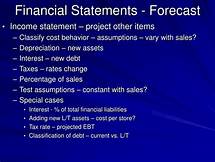What Is Financial Forecasting?
Financial forecasting is a process of conducting a method of predicting or estimating the business’s future performance. From this task, you will know how the business’s finances will look; for example, you will expect the company’s revenue.
Financial forecasting is essential in business planning, budgeting, and operations management. Business leaders, investors, and creditors review these forecasts to assess projected revenues and expenses to estimate a company’s cash flow throughout the accounting period.
A company’s key stakeholders rely on financial forecasts to decide to purchase, hire, and make capital expenditures. Managers need economic forecasts to create budgets.
Companies usually issue financial forecasts for the upcoming quarter or year. Often, projections will cover multiple reporting periods.
The companies have to revise the forecasts at times because of changes in sales due to unforeseen factors.
Why Is Forecasting Important?
A business has to maintain its cash flow; therefore, the financial forecast is crucial for each accounting period as it wants to establish how it will cover the financial liabilities.
It also provides data that leaders rely on when creating budgets. Likewise, financial forecasts weigh heavily in decisions about significant capital expense, hiring, or other substantial investments. A valuable forecast indicates the resources needed, when needed, and how you will pay for them.
A business might prepare and include the estimations on a draft formant financial statement, like formal financial statements, except they show results for the past and future based on imaginary conditions. These statements go to investors or creditors, who will consider them when deciding whether to give the company additional funding. They’re also used to illustrate the impact of a recent or planned acquisition or merger. Financial forecasts are also critical for anyone creating a new business plan.
What are the methods of financial forecasting?
Finance teams create forecasts by gathering available data to improve their projections, including sales, labor expenses, cost of materials, and more. Much of that information comes from prior reporting periods, but finance employees also consider internal and external communication that could impact expenses or revenues.
The finance department has historically created simple forecasts in Excel spreadsheets, and many still do.
There are four different financial forecasting methods:
- Straight-line Method:
Considered the most straightforward approach to forecasting, planners use historical figures and trends to estimate revenue growth. Financial forecasts using this method typically have defined beginning and end dates. Financial analysts can use spreadsheets to create these forecasts.
- Moving Average:
Moving averages use repeated forecasts to develop estimates based on past performance and the patterns within. The most common moving average models are for three months and five months out.
3. Simple Linear Regression/Multiple Linear Regression:
It is a method of analyzing the relationship between a dependent and an independent variable. Using the simple linear regression method, if the trend line for sales (x-axis) and profits (y-axis) rises, all is well for the company, and margins are strong.
- Time Series:
A time-series method uses numbers from specific time intervals, like the last several months, to predict future performance in the short term. For example, a distributor may look at revenue numbers and monthly growth over the past three months to forecast results for the upcoming month. Alternatively, an energy company could use it to predict oil prices over the next two months.



